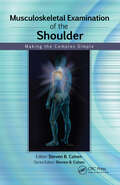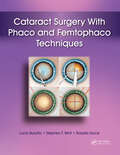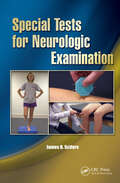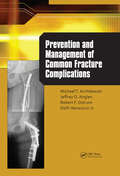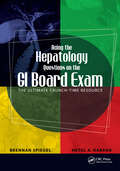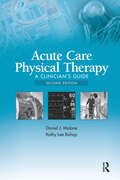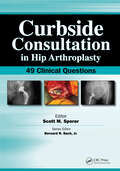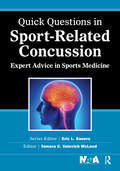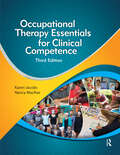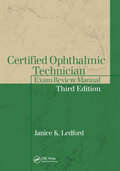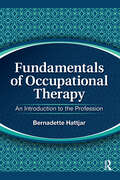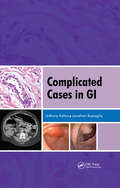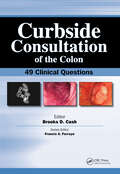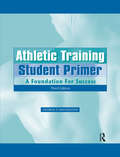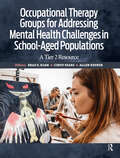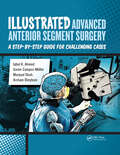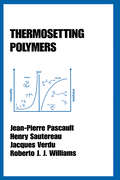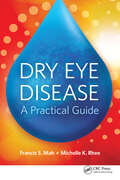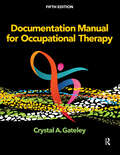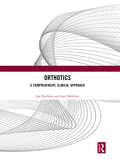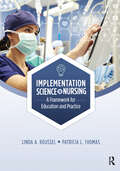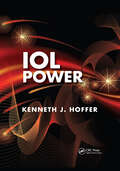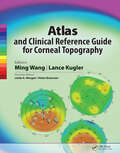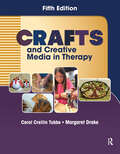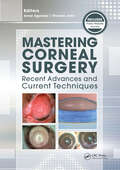- Table View
- List View
Musculoskeletal Examination of the Shoulder: Making the Complex Simple
by Steven CohenThe physical examination of the shoulder can be a complex topic for professionals with all levels of clinical experience. How can advance concepts be taught in a user-friendly, clear format, while still providing necessary information for effective diagnosis and treatment of the shoulder?Musculoskeletal Examination of the Shoulder: Making the Complex Simple by Dr. Steven B. Cohen answers these questions. Written by experts, this easy-to-carry book provides a thorough review of the most common pathologic shoulder conditions, techniques for diagnosis, as well as the appropriate treatment for each condition.Musculoskeletal Examination of the Shoulder: Making the Complex Simple contains clear photographic demonstrations, tables, and charts throughout its pages, allowing a thorough and concise examination of the shoulder.A glance at some of what is covered inside:• Physical Examinationo Basics and specific tests of the physical examination of the shoulder• General Imagingo Basics of general imaging of the shoulder• Common Conditions o Superior labrar tears, Biceps tendon, Glenohumeral arthritis, and moreMusculoskeletal Examination of the Shoulder: Making the Complex Simple contains essential information to successfully take a complex subject and bring it to a level that will be welcomed by orthopedic residents, attendings, physical therapists, athletic trainers, medical students in training, and other health care providers.
Cataract Surgery With Phaco and Femtophaco Techniques
by Lucio Buratto Stephen Brint Rosalia SorceCataract Surgery With Phaco and Femtophaco Techniques offers a unique insight into the evolution of phacoemulsification machines and the development of new ways to supply energy, as well as new devices that improve fluidics therefore increasing the safety of the phaco and femtophaco surgical procedures. Dr. Lucio Buratto, Dr. Stephen Brint, and Dr. Rosalia Sorce provide a step-by-step approach to everything the surgeon must learn about the physical principles that regulate the fluidics and energy to understand the machine’s working during the surgical procedure. Cataract Surgery With Phaco and Femtophaco Techniques covers a wide variety of topics, including anterior chamber phacoemulsification, endocapsular techniques, irrigation and aspiration, fluidics and pumps, and principles of femtosecond cataract surgery. Supplemented by more than 300 color illustrations, diagrams, a glossary, and references, all surgeons from beginner to expert will want this unique resource by their side.
Special Tests for Neurologic Examination
by James ScifersIdeal for students and clinicians to access quick clinical information, Special Tests for Neurologic Examination offers invaluable evaluation and assessment tips and techniques for neurologic conditions commonly found in patients. Organized in an easy-to-use format, this book is the perfect guide for practicing clinical skills and reviewing for licensure and certification examinations.Dr. James R. Scifers describes and illustrates special tests for the upper extremity, lower extremity, and spine. This resource provides performance criteria for each special test, important information on specificity and sensitivity, and valuable references for further investigation. Inside you’ll find: • Techniques for dermatome, myotome, reflex screening, and concussion testing • Examples of various concussion grading scales and neuropsychological tests • Special design that facilitates use of the book as a user-friendly study guide and quick clinical reference • Data on test specificity and sensitivity to assist clinicians in determining the value and strength of various clinical examination procedures • Additional resources for further study and exploration A facilitative and comprehensive approach to learning, practicing, and reviewing neurologic special tests makes Special Tests for Neurologic Examination a must-have for students and clinicians alike. With a focus on commonly used evaluative procedures for differentiating and diagnosing neurologic disorders, the book serves as a valuable companion to the popular Special Tests for Orthopedic Examination.
Prevention and Management of Common Fracture Complications
by Dolfi Herscovici Michael Archdeacon Jeff Anglen Robert OstrumEvery orthopedic surgeon faces complications in the management of fractures. Drs. Michael T. Archdeacon, Jeffrey O. Anglen, Robert F. Ostrum, and Dolfi Herscovici, Jr. have created Prevention and Management of Common Fracture Complications, a comprehensive reference dedicated entirely to the prevention and management of fracture complications. Prevention and Management of Common Fracture Complications is arranged on an anatomic basis with contributions from more than 45 orthopedic surgeons. Each contributor is considered an expert on the topic covered in their respective sections of the book.Some Chapters Include:• The etiological factors for each complication• Strategies for preventing the complication• Surgical techniques• Reduction and implant selection• Strategies required to successfully manage the complicationPrevention and Management of Common Fracture Complications also includes more than 300 images and more than 45 tables.Prevention and Management of Common Fracture Complications offers a single and complete resource to readily answer all fracture complication questions and is ideal for orthopedic surgeons, orthopedic residents, and medical students interested in orthopedic surgery.
Acing the Hepatology Questions on the GI Board Exam: The Ultimate Crunch-Time Resource
by Brennan Spiegel Hetal KarsanHepatology is an expanding field - it's hard to keep up. The liver has been sitting there the whole time, but the knowledge surrounding this perplexing organ is exploding; this makes it hard to prepare for board and recertification exams, where 1 in every 4 questions pertains to hepatology. Until now, there has been no single, slim, but high-yield volume that summarises the hepatology you need to know for the boards. This book has it nailed. The authors have collected every pearl of wisdom, high-yield factlet, liver ""board buzzword,"" hepatic micrograph, and classic liver imaging study they could muster, all while keeping the book a manageable size - because who has time for more than manageable when you're busy?The answer to your study questions (and study time!) can be found inside: Acing the Hepatology Questions on the GI Board Exam: The Ultimate Crunch-Time Resource.Traditional textbooks usually feature long and detailed discussions that are not directly related to Board and recertification exams. On the flip side, many Board review manuals provide lists and bullet points lacking sufficient background and context. Inside Acing the Hepatology Questions on the GI Board Exam, Drs. Brennan Spiegel and Hetal Karsan present time-tested and high-yield information in a rational, useful, and contextually appealing format.With its focus on pearl after pearl, emphasis on images, and attention to high-yield "tough stuff" vignettes you don't know the answers to (yet), Acing the Hepatology Questions on the GI Board Exam is truly the ultimate crunch-time resource for acing often vexing liver section of the examination, taking recertifying examinations, looking good on clerkship rounds, or for just challenging yourself with interesting and entertaining vignettes.
Acute Care Physical Therapy: A Clinician’s Guide
by Daniel J. Malone Kathy Lee BishopAcutely ill patients are found in the hospital, in the skilled nursing facility, in inpatient rehabilitation facilities, in outpatient practices, and in the home. The role of the physical therapist and physical therapist assistant is to rehabilitate these vulnerable and frail patients to enhance their health and functioning. The goal of Acute Care Physical Therapy: A Clinician’s Guide, Second Edition is to provide the acute care practitioner with the necessary knowledge to improve patients’ structural impairments and activity limitations so they can more successfully participate in life. Nothing could be more challenging and rewarding. Inside, Drs. Daniel Malone and Kathy Lee Bishop, along with their contributors, provide a comprehensive review of acute care physical therapist best practice. This text builds upon fundamental knowledge by addressing important components of the patient examination ranging from the patient’s medical history to laboratory testing to life supporting equipment. Following this introduction, each chapter highlights specific organ systems with a review of pertinent anatomy and physiology followed by common health conditions and medical management. Important physical therapy concerns, examination findings, and rehabilitation interventions are discussed in detail. This Second Edition includes numerous tables, figures, review questions, and case studies that highlight clinical reasoning and the physical therapy patient care model as outlined in the Guide to Physical Therapist Practice. New in the Second Edition: Increased focus on evidence-based examination, evaluation, and intervention The latest technology in physiologic monitoring and patient support equipment Introduces the “PT Examination” and “ICU” algorithms to promote safe and progressive rehabilitation Emphasis on clinical decision making through the application of a clinical reasoning model applied to the end of chapter cases Acute Care Physical Therapy: A Clinician’s Guide, Second Edition will serve as a valuable education tool for students, newer professionals as well as post-professionals who provide therapy services to the acutely ill patient regardless of setting.
Curbside Consultation in Hip Arthroplasty: 49 Clinical Questions (Curbside Consultation in Orthopedics)
by Scott SporerAre you looking for concise, practical answers to those questions that are often left unanswered by traditional hip arthroplasty references? Are you seeking brief, evidence-based advice for complicated cases or controversial decisions? Curbside Consultation in Hip Arthroplasty: 49 Clinical Questions provides quick answers to the thorny questions most commonly posed during a “curbside consultation” between orthopedic surgical colleagues. Dr. Scott Sporer has designed this unique reference which offers expert advice, preferences, and opinions on tough clinical questions commonly associated with hip arthroplasty. The unique Q&A format provides quick access to current information related to hip arthroplasty with the simplicity of a conversation between two colleagues. Numerous images, diagrams, and references are included to enhance the text and to illustrate the management of the hip.Curbside Consultation in Hip Arthroplasty: 49 Clinical Questions provides information basic enough for residents while also incorporating expert advice that even high-volume clinicians will appreciate. Practicing orthopedists, orthopedic residents, and non-physician personnel will benefit from the user-friendly and casual format and the expert advice contained within.Some of the questions that are answered: How do you treat a young patient with severe hip arthritis? When should they be indicated for surgery? What type of components should I use? What should I do when I suspect a patient has an infected hip? When do I need to remove his/her prosthesis? How do I treat a fracture of the femur when it occurs with surgery? several years post-surgery? What should I tell a patient that has persistent pain following a hip replacement and how should they be evaluated? How can I determine the severity of acetabular and femoral bone loss? What should I do to reconstruct the deficient bone?
Quick Questions in Sport-Related Concussion: Expert Advice in Sports Medicine (Quick Questions in Sports Medicine)
by Tamara McLeodAre you looking for concise, practical answers to questions that are often left unanswered by traditional sports medicine references? Are you seeking brief, up-to-date, expert advice for common issues that can be encountered when working with athletes?Quick Questions in Sport-Related Concussion: Expert Advice in Sports Medicine provides a unique format of concise and to the point responses with clinical application, backed by the latest research on sport-related concussions among athletes. Dr. Tamara C. Valovich McLeod and her contributors present 39 common clinical questions and answers based on the author’s experience and the many different guidelines, consensus, and position statements that have garnered increased attention in the media and literature. Co-published with the National Athletic Trainers’ Association, Quick Questions in Sport-Related Concussion: Expert Advice in Sports Medicine provides concise answers to 39 frequently asked clinical questions. Written in a conversational tone, the authors of the individual questions represent a variety of different backgrounds and are experts in their respective field. The variety of questions and brevity of responses will make this a book that is easy to read and reference at the point of care.Some sample sections and questions include: Concussion BasicsWhat are the best educational materials available to help a coach, parent, or athlete learn about concussions? Pre-Season PlanningWhat are the most important regulations and policies to consider regarding the management of sport-related concussion? Concussion assessmentHow common are vestibular deficits following sport-related concussion and what tools are best used to assess vestibular function? Concussion management considerationAre there any rehabilitation exercises you can do to help a concussed athlete heal faster? Return to activityWhat is the role of the graded exertion protocols for making RTP decisions? Return to schoolWhat is cognitive rest and can it help recovery following concussion? Quick Questions in Sport-Related Concussion: Expert Advice in Sports Medicine is the perfect at-your-side resource for the athletic trainer, team physician, or sports medicine clinician looking for practical answers to sport-related concussion questions. The concise and conversational tone allows the reader to readily apply the information into their everyday practice.
Occupational Therapy Essentials for Clinical Competence
by Karen Jacobs Nancy MacRaeOccupation, theory-driven, evidence-based, and client-centered practice continue to be the core of the profession and are the central focus of Occupational Therapy Essentials for Clinical Competence, Third Edition.The Third Edition contains updated and enriched chapters that incorporate new perspectives and evidence-based information important to entry-level practitioners. The Third Edition continues to relate each chapter to the newest ACOTE Standards and is evidence-based, while also addressing the guidelines of practice and terms from the AOTA’s Occupational Therapy Practice Framework, Third Edition.Dr. Karen Jacobs and Nancy MacRae, along with their 61 contributors, introduce every topic necessary for competence as an entry-level practitioner. Varied perspectives are provided in each chapter with consistent references made to the relevance of certified occupational therapy assistant roles and responsibilities.Additionally, chapters on the Dark Side of Occupation and Primary Care have been added to broaden the foundational scope of knowledge. Each chapter also contains a clinical case used to exemplify relevant content.New in the Third Edition: All chapters have been updated to reflect the AOTA’s Occupational Therapy Practice Framework, Third Edition Updated references and evidence-based practice chart for each chapter Updated case studies to match the current standards of practice References to the Occupational Therapy Code of Ethics (2015) Faculty will benefit from the multiple-choice questions and PowerPoint presentations that coincide with each chapter Included with the text are online supplemental materials for faculty use in the classroom.Occupational Therapy Essentials for Clinical Competence, Third Edition is the perfect multi-use resource to be used as an introduction to the material, while also serving as a review prior to sitting for the certification exam for occupational therapists and occupational therapy assistants.
Certified Ophthalmic Technician Exam Review Manual (The Basic Bookshelf for Eyecare Professionals)
by Janice K. LedfordAs the field of eye care has advanced, so have the knowledge and skills needed to best care for our patients. Certification is a way to hold the profession to a high standard that is appreciated (and in some cases, required) by clinics and offices everywhere.For the past 30 years, Janice K. Ledford's exam review manuals have been the must-have certification study aids used by those wishing to advance their careers with increased knowledge and certification. This third edition of Certified Ophthalmic Technician Exam Review Manual provides the ultimate experience in exam preparation.This best-selling text is ideal for both individual and group study. The explanatory answers contribute to your understanding of the material, rather than only providing right or wrong feedback. Certified Ophthalmic Technician Exam Review Manual, Third Edition expands on what was originally the only study material available for this highly specialized exam. It remains the go-to source for the most questions and explanatory answers and has been updated to the latest IJCAHPO® criteria. With more than 1800 questions, this text covers all 22 of IJCAHPO's® criteria subjects at the COT® level.
Fundamentals of Occupational Therapy: An Introduction to the Profession
by Bernadette HattjarFundamentals of Occupational Therapy: An Introduction to the Profession is a comprehensive, introductory text that provides first year students with foundational knowledge of occupational therapy as a profession and the construct of occupation. Due to the broadness of the profession this text identifies basic concepts and areas to novice students and helps inform them of the topics and components they will come across later in their studies.Inside the text, Dr. Bernadette Hattjar provides a general introduction, the historical development of the profession, and a basic review of the three major employment areas- physical disabilities, pediatrics and psychosocial occupational therapy. It also covers the topics of theoretical constructs, legislative and political influences on the profession, the use of adaptive devices in concert with major client groups, and the identification of influential professional individuals. Fundamentals of Occupational Therapy analyzes the historical foundation, philosophical assumptions, ethical issues, core concepts, theories, models and frames of reference that have shaped the profession of occupational therapy.Fundamentals of Occupational Therapy: An Introduction to the Profession will provide entry level occupational therapy and occupational therapy assistant students with the information and tools they need to better understand, synthesize, and integrate the diverse elements of the profession into professional level courses, where in-depth understanding of these basic concepts occur in education programs.
Complicated Cases in GI
by Anthony KallooDr. Anthony Kalloo and Dr. Jonathan M. Buscaglia have taken years of experience at Johns Hopkins Hospital and created a collection of unique and interesting cases revolving around gastrointestinal and liver diseases.Complicated Cases in GI follows patient-physician interactions and includes over 50 cases that are complex in their nature, interesting in their presentations, or a representation of a unique therapeutic challenge. Each chapter case includes: • A detailed summary of a particular patient presentation • Associated pathology slides, radiology films, or endoscopy photographs • A brief evidence-based discussion focusing on the main learning objectives • Three to five key learning points listed to highlight the most important featuresComplicated Cases in GI also includes 150 board review-like questions taken directly from the cases themselves. The questions highlight the salient aspects and are meant to reinforce the learning objectives involved in each case. They will also serve as a useful study aid for anyone preparing for an examination in general medicine, gastroenterology or hepatology.Complicated Cases in GI is ideal for residents, fellows, practicing physicians preparing for recertification, nurses, and students looking for a quick reference text that can be read and absorbed over time—one case at a time.
Curbside Consultation of the Colon: 49 Clinical Questions (Curbside Consultation in Gastroenterology)
by Brooks D. CashAre you looking for concise, practical answers to questions that are often left unanswered by traditional medical searches? Are you seeking brief, evidence-based advice for complicated cases or complications? Curbside Consultation of the Colon: 49 Clinical Questions provides quick and direct answers to the thorny questions commonly posed during a “curbside consultation” between colleagues. Dr. Brooks D. Cash has designed this unique reference, which offers expert advice, preferences, and opinions on tough clinical questions commonly associated with the colon. The unique Q&A format provides quick access to current information related to the colon with the simplicity of a conversation between two colleagues. Numerous images, diagrams, and references are included to enhance the text and to illustrate the treatment of the colon.Curbside Consultation of the Colon: 49 Clinical Questions provides information basic enough for residents while also incorporating expert advice that even high-volume clinicians will appreciate. Gastroenterologists, fellows and residents in training, surgical attendings, and surgical residents will benefit from the user-friendly and casual format and the expert advice contained within.Some of the questions that are answered: What is the appropriate evaluation for fecal incontinence? What colonic infections are associated with AIDS? What are the current colorectal cancer screening and surveillance recommendations? What is the best way to manage chronic constipation? Where do probiotics fit into the management of IBS? How should diverticulitis be managed? What is colonic pseudo-obstruction and how is it managed?
Athletic Training Student Primer: A Foundation for Success
by Andrew P. WintersteinAthletic Training Student Primer: A Foundation for Success, Third Edition is a dynamic text that provides students with a foundation upon which they can build their athletic training knowledge and develop an authentic understanding of the rewards and challenges of the athletic training profession. The Third Edition of Athletic Training Student Primer: A Foundation for Success by Andrew P. Winterstein builds upon previous editions in providing a mix of foundational athletic training knowledge coupled with human interest information to help guide students in their decision-making process when contemplating a career. This Third Edition breaks the mold of other introductory athletic training texts by including answers to many "real-life" athletic training situations. The Third Edition is broken into four sections that cover all different aspects of the profession: Understanding athletic training Common injuries and conditions Planning, prevention, and care Preparing for success Further expanding the learning process, included with each new textbook purchase is access to a companion website that includes videos, a glossary, and various web resources.Updated Features Include: New injury spotlights for the upper and lower extremity and general medical conditions Updated information from athletic training students on keys to success New career spotlights from athletic trainers working in a broad range of career settings Updated information on historic changes in athletic training, including the upcoming transition to master’s degree for professional preparation Updated web resources Additional resources for instructors Complete redesign of text layout and updated images Athletic Training Student Primer: A Foundation for Success, Third Edition is a must have for students taking the first step into a career in athletic training.
Occupational Therapy Groups for Addressing Mental Health Challenges in School-Aged Populations: A Tier II Resource
by Brad Egan Cindy Sears Allen KeenerA new resource for school-based occupational therapists, Occupational Therapy Groups for Addressing Mental Health Challenges in School-Aged Populations: A Tier 2 Resource is a collection of occupation-based group interventions and tools that can be used to support students at risk for or with identified mental health challenges.School-wide mental health programs are increasing and expanding. School-based occupational therapists are uniquely positioned to collaborate with traditional school mental health practitioners and provide an occupational perspective on how mental health can impact school performance and participation in academic occupations.Occupational Therapy Groups for Addressing Mental Health Challenges in School-Aged Populations is organized into different sections to assist the occupational therapy practitioner or occupational therapy student in considering different aspects of providing mental health services in schools. The text serves as a flexible compendium of group activities and interventions designed to promote positive mental health for all students and support students at risk for or with identified mental health challenges.What’s included in Occupational Therapy Groups for Addressing Mental Health Challenges in School-Aged Populations: Cases to help recognize the occupational impact of internalizing and externalizing behaviors A quick reference of common assessments and screening tools Occupation-based Tier 2 group protocols and data collection tool templates An online section for occupational therapy and occupational therapy assistant educators with ideas for learning assignments, rubrics, and classroom activities to prepare prelicensure learners for addressing school mental health needs once they enter practice Occupational Therapy Groups for Addressing Mental Health Challenges in School-Aged Populations: A Tier 2 Resource expresses the valued contribution that occupational therapists make to school mental health initiatives while also addressing a major gap—a Tier 2–focused resource with intervention ideas and tools for answering this urgent call to practice.
Illustrated Advanced Anterior Segment Surgery: A Step-by-Step Guide for Challenging Cases
by Arsham Sheybani Iqbal Ahmed Xavier Möller Manjool ShahFor general ophthalmologists looking to expand their surgical skillsets, anterior segment surgery specialists wishing to learn new techniques, and residents looking to separate themselves from the pack, Illustrated Advanced Anterior Segment Surgery: A Step-by-Step Guide for Challenging Cases is a must-have resource. The book provides a wide range of advanced anterior segment surgery techniques, presented in a highly designed graphic style. Editors Iqbal “Ike” Ahmed, Xavier Campos-Möller, Manjool Shah, and Arsham Sheybani have created a dynamic visual guide that emphasizes images and diagrams and includes step-by-step illustrations to help readers understand the optimal hand positions for certain surgical maneuvers. Each chapter focuses on an individual technique, allowing readers to consult specific chapters as needed. There is significant emphasis on both foundational concepts and advanced surgical techniques, including: Ergonomics, hand positioning, and instrument grips How to insert and remove iris hooks Capsulorhexis in the setting of weak zonules How to perform intrascleral haptic fixation of a three-piece IOL How to repair an iridodialysis cleft With its unique graphic approach and easily digestible format, Illustrated Advanced Anterior Segment Surgery: A Step-by-Step Guide for Challenging Cases will help surgeons take their skills to the next level and tackle some of the most challenging cases in anterior segment surgery.
Thermosetting Polymers
by Jacques Verdu Jean-Pierre Pascault Roberto J. Williams Henry SautereauProvides comprehensive coverage of the most recent developments in the theory of non-Archimedean pseudo-differential equations and its application to stochastics and mathematical physics--offering current methods of construction for stochastic processes in the field of p-adic numbers and related structures. Develops a new theory for parabolic equat
Dry Eye Disease: A Practical Guide
by Michelle Rhee Francis MahDue to the growing population of dry eye patients, there has been much study of dry eye disease. Following the full reports of the International Dry Eye Workshops of 2007 and 2017 (DEWS I and II), as well as the recent Dry Eye Assessment and Management (DREAM) trial, there is a growing body of consensus and evidence-based literature on the treatment of dry eye. Dry Eye Disease: A Practical Guide synthesizes all these scientific sources into a comprehensive, yet, user-friendly clinical reference. From epidemiology and pathogenesis, to disease subgroups, diagnostics, and management, Drs. Francis Mah and Michelle Rhee with their team of over 35 renowned contributors have distilled all the latest information on dry eye disease into an easily digestible guide. Featuring diverse case scenarios pulled from clinical practice, Dry Eye Disease engages the reader and encourages critical thinking to apply current understanding of dry eye disease to the office and operating room. All aspects of this complex disease are discussed, including the relationship between dry eye and surgical outcomes and contact lens wear. Some topics include: The latest biomarker diagnostics Meibomian gland dysfunction therapeutic technologies The role of integrative medicine Advances in therapeutic contact lenses Ophthalmologists and optometrists of all specialties and skill levels will find Dry Eye Disease: A Practical Guide a comprehensive yet practical clinical guide for treating the growing population of dry eye patients.
Documentation Manual for Occupational Therapy
by Crystal GateleyThe best-selling, newly updated occupational therapy textbook Documentation Manual for Occupational Therapy, Fifth Edition, is made for students and early-career practitioners learning the critical skill of documentation. The workbook format offers students ample opportunities to practice writing occupation-based problem statements and goals, intervention plans, SOAP notes, and other forms of documentation. The Fifth Edition has also been updated to reflect changes in the American Occupational Therapy Association’s Occupational Therapy Practice Framework: Domain and Process, Fourth Edition. What’s included in Documentation Manual for Occupational Therapy:• Numerous worksheets for students to practice individual skills with suggested answers provided in the Appendix• Updated information on coding, billing, and reimbursement to reflect recent Medicare changes, particularly in post–acute care settings• Examples from a variety of contemporary occupational therapy practice settings Included with the text are online supplemental materials for faculty use in the classroom. Instructors in educational settings can visit the site for an Instructor’s Manual with resources to develop an entire course on professional documentation or to use the textbook across several courses. One of the most critical skills that occupational therapy practitioners must learn is effective documentation to guide client care, communicate with colleagues, and maximize reimbursement. The newly updated and expanded Documentation Manual for Occupational Therapy, Fifth Edition, will help students master their documentation skills before they ever step foot into practice.
Orthotics: A Comprehensive Clinical Approach
by Joan Edelstein Jan BrucknerOrthotics: A Comprehensive Clinical Approach is an innovative and comprehensive new text that provides essential information about contemporary orthoses to guide the student and clinician in prescribing and utilizing these appliances in neuromuscular, musculoskeletal, and integumentary rehabilitation.Written by recognized authorities in the field, Joan Edelstein, MA, PT, FISPO and Jan Bruckner, PhD, PT, this is a prime resource for practitioners and clinicians.Individual chapters cover orthoses for the foot, ankle, knee, hip, trunk, neck, shoulder, elbow, wrist, and hand. Orthoses for patients with paraplegia, burns, and soft tissue contractures are detailed and illustrated. Prescription guidelines, evaluation techniques, goal setting, and training procedures are presented. Each chapter has interesting thought questions and case studies to promote clinical reasoning and problem-solving skills. A unique feature of this text is the inclusion of a point-counterpoint discussion to demonstrate how clinicians can manage the same patient in different ways. This approach inspires broader thinking about clinical management.
Implementation Science in Nursing: A Framework for Education and Practice
by Patricia Thomas Linda RousselA timely resource that shows faculty, students, and clinicians how to bring about and sustain change, Implementation Science in Nursing: A Framework for Education and Practice provides theoretical information and practical application for evidence-based practice (EBP) in health care.The most challenging but crucial part of EBP is implementation, where the practice change is piloted, evaluated, integrated, and sustained. Implementation Science in Nursing: A Framework for Education and Practice focuses on the implementation process, which is the study of methods and strategies that promote the methodical uptake of research findings and EBPs into routine practices to ultimately improve patient care, quality, safety, and outcomes. Drs. Linda A. Roussel and Patricia L. Thomas have combined both didactic teaching methods with real-life exemplars in the text to help readers learn the elements of implementation science and its application. Other important features include: • Excellent exemplars and sample assignments for educators• In-depth discussions on implementation science theories, models, and frameworks applied to real-life scenarios• Thorough explanations of evidence-based practice (EBP), quality improvement (QI) implementation science (IS), and dissemination science (DS)• The latest literature and thinking on implementation scienceWith Implementation Science in Nursing: A Framework for Education and Practice, nursing professionals and students in Doctor of Nursing Practice programs will learn the tools, techniques, and strategies used to advance quality initiatives and improve patient and population health.
IOL Power
by Kenneth HofferIOL Power by Kenneth J. Hoffer, MD will be the definitive resource worldwide for ophthalmologists who strive to increase the accuracy for all IOL calculations,especially for multifocal IOLs and overcoming the challenges that arise when treating patients that have had laser refractive surgery, such as RK, PRK, LASIK, and LASEK.Inside the pages of IOL Power, Dr. Hoffer is joined by some of the most respected international physicians and physicists in the field of IOL power such as Aramberri, Haigis, Norrby, Olsen and Shammas. Together their expertise, spanning over 35 years, makes even the most difficult subjects easy to understand.This volume will become the definitive reference source on the subject of IOL power calculation.Some topics include: Ultrasound velocities for axial length measurement Optical AL (IOLMaster and Lenstar) in difficult eyes Manual and automatic keratometry and instrumentation Topography & Scheimpflug camera corneal power Value of theoretic formulas Formula personalization Multifocal and toric IOLs Aspheric IOLs Effect of IOL tilt on astigmatism Chapters Cover: All aspects of obtaining the most accurate biometry Available modern calculation formulas Latest instruments Problems that can arise, how to prevent and repair them IOL Power by Kenneth J. Hoffer, MD is structured in a logical manner so as to cover every facet of IOL power from the basics to the most complicated subjects to achieve the most accurate and precise calculations and should be in the hands of all ophthalmic surgeons, technicians, residents and students.
Atlas and Clinical Reference Guide for Corneal Topography
by Ming Wang Lance KuglerCorneal topography has become essentially a pattern recognition trade, best learned by viewing multiple images of representative patterns. In spite of this, currently available topography books focus only on the technology behind topography, or a particular application of topography, as opposed to presenting a comprehensive collection of topographic patterns that provide quick, consistent pattern recognition and identification. Drs. Wang and Kugler, along with Drs. Morgan and Boerman, look to fill this void with Atlas and Clinical Reference Guide for Corneal Topography.Atlas and Clinical Reference Guide for Corneal Topography is the first corneal topography book that lends itself to efficient image search and reference for busy clinicians at chair side. Organized into both map-based and disease-based sections, the book allows for quick reference in busy clinical situations. Images come from the commonly used topographers, the Zeiss Atlas and the Oculus Pentacam, but the principles of pattern recognition can be applied to any topographer. Due to the text’s large collection of topographic images and corresponding corneal conditions, Atlas and Clinical Reference Guide for Corneal Topography can be used side by side with the topographer.Designed as both a learning tool for students and a reference for clinicians to use when faced with a challenging topography interpretation, Atlas and Clinical Reference Guide for Corneal Topography will be appreciated by a wide spectrum of eye care professionals. General ophthalmologists, cataract and refractive surgeons, corneal specialists, optometrists, and ophthalmology residents and students will benefit from this invaluable atlas for corneal topography.
Crafts and Creative Media in Therapy
by Margaret Drake Carol TubbsFor more than 20 years, Crafts and Creative Media in Therapy, Fifth Edition has been an illuminating reference for the use of creative approaches in helping clients achieve their therapeutic goals. Carol Crellin Tubbs has included a range of craft and creative activity categories, from paper crafts, to cooking, to the use of recycled materials, and everything in between.Each chapter includes a brief history of the craft, several projects along with suggestions for grading or adapting, examples of related documentation, and a short case study. The text also features chapters on activity analysis, general strategies for implementation of creative activities, and documentation, as well as a chapter describing the relevance of this media from both historical and current occupation-based perspectives.In this updated Fifth Edition, the craft projects have been updated and numerous resources and links for more ideas have been added. There are new chapters on making therapy tools and crafting with a purpose, and the recycled and found materials chapter has been expanded in keeping with cultural trends. A flow chart has been added to each case study to help students better understand the process and rationale for tailoring activities for individual client needs, and project suggestions for working on specific performance skills or client factors are scattered throughout the chapters. Other additions include a behavioral observation checklist as an aid in evaluation and documentation, and several illustrations to help students distinguish between the use of occupation as means and occupation as end. This Fifth Edition also includes an updated instructors’ manual with additional resources and suggestions for lesson planning.Crafts and Creative Media in Therapy, Fifth Edition not only provides a wide assortment of craft ideas and instructions, but also provides multiple suggestions for therapeutic uses for activities in each category. It includes ways to grade activities to best achieve therapy objectives, and examples of documentation for reimbursement. For each craft category, there is discussion on precautions for use with certain populations, contextual limitations, and safety considerations. Information is presented in several different formats such as examples, tables, illustrations, and other formats to promote student understanding.Included with the text are online supplemental materials for faculty use in the classroom. .Crafts and Creative Media in Therapy, Fifth Edition is the foremost resource for using creative approaches in helping clients achieve their therapeutic goals and should be used by all occupational therapists, occupational therapy assistants, and recreational therapists.
Mastering Corneal Surgery: Recent Advances and Current Techniques
by Thomas John Amar AgarwalMastering Corneal Surgery: Recent Advances and Current Techniques comprehensively covers all the recent advances in the existing techniques for common and rare corneal conditions, as well as presents the potential intraoperative circumstances the surgeon can face with their patients.Mastering Corneal Surgery: Recent Advances and Current Techniques by Drs. Amar Agarwal and Thomas John, along with more than 50 contributors, cover the most recent innovations in corneal surgery, including corneal procedures in combination with IOL implantation in eyes with deficient capsules, and combining endothelial keratoplasty with IOL repositioning.Bonus!Extensive high-quality video demonstrations of the techniques discussed inside Mastering Corneal Surgery: Recent Advances and Current Techniques enhances the written text, creating a superior companion website resource. The 28 videos, combined with the written text, clinical photographs and pictures, furthers the learning process more than learning from text or video alone.Mastering Corneal Surgery: Recent Advances and Current Techniques covers all the recent advances in the existing techniques for common and rare corneal conditions and presents the potential intraoperative circumstances the surgeon can encounter with their patients. The general ophthalmologist and cornea specialist will welcome the novel surgical methods and their differences from the existing techniques highlighted inside this cutting-edge resource.
